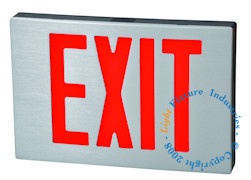Confused? We’ve Got You Covered!
Our customers’ needs come in all shapes and sizes. Some are replacing an old exit sign, some are putting up fire exit signs where none existed before and some still haven’t finished construction on the building! No matter what situation brought you here, it can be overwhelming to sort through the selection of exit signs available.
First things first: Have you consulted your local building inspector or fire marshal? Even if you’ve never been inspected before, conforming with local building and fire codes is mandatory. Therefore understanding local building and fire codes will prove to be invaluable. Check out our Fire Exit Codes & Regulations section. Consider the following questions:
Are there any color or materials requirements my exit signs have to meet?
Certain locales require that exit signs have red lettering, others require green lettering, others allow either but may require consistency within a facility (all green or all red). Some locales require that exit signs be enclosed in steel enclosures, other allow fire-retardant plastic, etc. The City of Chicago require steel exit signs with a glass face. The New York City requires that exit signs have 8” red lettering and be enclosed in durable steel housing. Make sure you are not subject to some of these very limiting requirements.
How many and/or in what areas are exit signs required?
General requirements state that any exit be marked accordingly, but some codes require marking of the “route” to get to the exit as well.
Is there a particular certification my signs need to carry?
The most widely used certification agency in the United States is Underwriters Laboratories Inc. (UL), but some areas require ETL SEMKO certification or other certifications that are more specific. Canada requires a certification from the Canadian Standards Association (CSA).
Are there certain types of units that are prohibited?
Some codes require that your units be hardwired (eliminating power-free choices) or a certain color/material (see question 1).
Once you have gathered the above information from your local authority, it is time for you to make some decisions of your own:
Do I have a particular look in mind?
Your local codes may not require it, but perhaps a brushed cast-aluminum sign with lettering fits best with your décor. Maybe you’ve seen an edge lit sign in your favorite store and liked the look, it’s up to you!
Do I have size constraints and/or how do I plan to mount my units?
This question alone may limit your selection to only a few items. Remember that certain mounting configurations may require the use of a mounting canopy that adds 1-2” to the height or width of your sign.
This question also encompasses limitations such as a sheet rock, drop or low ceiling.
Will these units be subject to abuse or hazardous environments?
In areas such as schools, gyms, warehouses and parking structures, exits signs may be subject to vandalism, damage from sports equipment and other types of situations which would limit your selection to heavy duty construction or protection such as a wire guard.
If installing in areas where the units will be exposed to chemicals, abrasive substances or other hazardous materials, your selection should be limited to units “rated” or qualified for installation in these environments.
By now you will have gathered enough information to narrow your choices to maybe even just one unit! If you are having trouble navigating our site – feel free to contact one of our award winning customer service professionals via phone, email or live chat with your requirements and we will be happy to assist you.

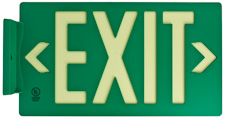 While all fire exit signs are required to be illuminated, not all models require electricity. UL 924 listed fire exit signs are available in AC powered, non-electric self luminous Tritium or photoluminescent models all of which are compliant for use in the United States and Canada.
While all fire exit signs are required to be illuminated, not all models require electricity. UL 924 listed fire exit signs are available in AC powered, non-electric self luminous Tritium or photoluminescent models all of which are compliant for use in the United States and Canada.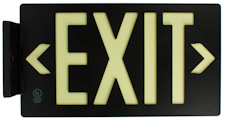 Photoluminescent signs, often referred to as “glow-in-the-dark” signs, absorb and store energy from normal ambient light, then release this energy in the form of a visible glow when the lights go out. Photoluminescent products automatically recharge once the lights are turned on, requiring approximately 60 minutes of exposure to 5 foot-candles or 54 LUX of natural light‡, fluorescent, metal halide or mercury vapor light.
Photoluminescent signs, often referred to as “glow-in-the-dark” signs, absorb and store energy from normal ambient light, then release this energy in the form of a visible glow when the lights go out. Photoluminescent products automatically recharge once the lights are turned on, requiring approximately 60 minutes of exposure to 5 foot-candles or 54 LUX of natural light‡, fluorescent, metal halide or mercury vapor light. 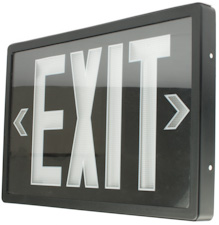 Self-luminous EXIT signs containing the radioactive gas tritium are widely used in a variety of facilities across the United States, such as public and private office buildings, theaters, stores, schools and churches – anywhere the public needs a rapid exit path. Those who possess tritium EXIT signs are general licensees of the Nuclear Regulatory Commission or an Agreement State, and are subject to certain reporting and handling requirements, including proper disposal of unwanted or unused signs. Tritium EXIT signs pose little or no threat to public health and safety and do not constitute a security risk.” —
Self-luminous EXIT signs containing the radioactive gas tritium are widely used in a variety of facilities across the United States, such as public and private office buildings, theaters, stores, schools and churches – anywhere the public needs a rapid exit path. Those who possess tritium EXIT signs are general licensees of the Nuclear Regulatory Commission or an Agreement State, and are subject to certain reporting and handling requirements, including proper disposal of unwanted or unused signs. Tritium EXIT signs pose little or no threat to public health and safety and do not constitute a security risk.” — 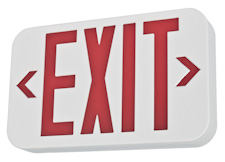 The real function of
The real function of 